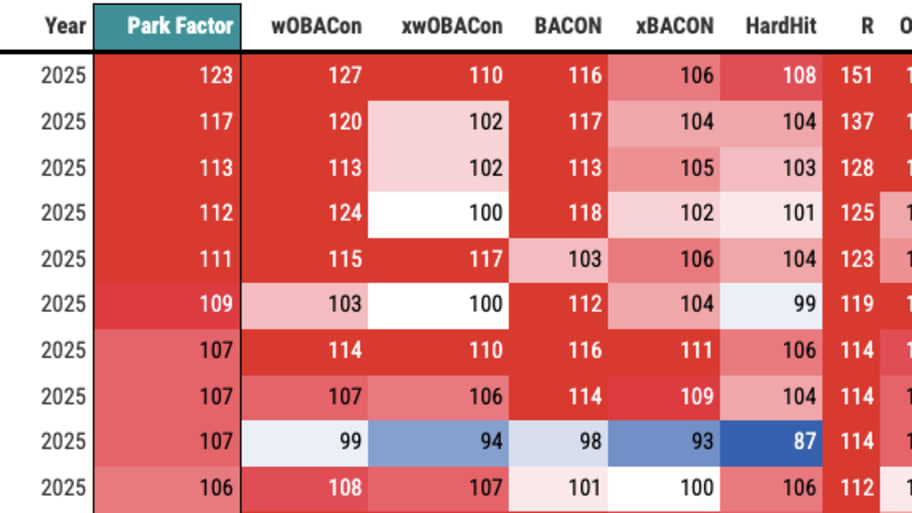
A common refrain after most home games for the A's this season has been that the team doesn't have enough data to make an honest assessment about how the park will play this season. While this is true, as one game against the Chicago Cubs, an 18-3 stomping by the visiting club, will skew some of the overall data, it certainly never hurts to ask.
That said, we can still take a look at how Sutter Health Park is playing when compared to other ballparks so far this season, with the huge caveat that these numbers are subject to change. Nothing is set in stone. Heck, we haven't even had a game in the warmer weather yet.
That said, here is what the data over at Baseball Savant is saying.

As you can see, Sutter Health Park is ranked third in overall park factors, serving as a well above average MLB ballpark. The Colorado Rockies being near the top of the rankings would suggest that some of the data is evening out already, as would having the Seattle Mariners ranking at No. 29.
Yet, there is one glaring park missing from the top-10 above: Great American Ball Park. In most years, the Reds' home ranks either first or second. Right now, it's ranked No. 30, which seems impossible. It's still a great park for the long ball, but overall offense is down so far. That should change as the weather begins to warm.
So when the A's say they don't have enough data yet, this is kind of what they mean. For Great American Ball Park, there are years of data to use as a reference. The A's don't have those years of data to pull from.
While the A's overall factors place them in the top-3 early in the year, in terms of home runs, it's roughly a league average park. Where they've seen a huge boost is in the number of triples in the ballpark, where they also rank third behind Wrigley Field (Cubs) and Kauffman Stadium (Royals).
Both of those parks still rank in the bottom half of the league in terms of park factors with Chicago's 98 coming in at No. 17, and Kansas City's 92 ranking 24th. The big difference is that those parks are also suppressing home runs (26th and 29th), while Sutter Health is playing middle-of-the-road.
To that point, we asked A's manager Mark Kotsay about the grass in the outfield playing particularly quick in the early days of the A's stay in West Sacramento. There have been a number of balls that have landed in the gap that have rolled all the way to the wall, oftentimes resulting in triples.
"I mean, you have to play both ends of this game here. And if you're trying to defend, as we see today, the wind, the wind direction, kind of impacted the game a little bit, with some balls getting hit really hard, and then get knocked down.
"We talked about a pregame with with that condition, you try to take away the ball in front of you in the air, and and you get beat in the gaps. And we've seen that both series, even with the Padres series, they got beat in the gaps.
It's kind of the field was playing fast. We knew that, and you know, we're still learning about it. But that's one of those learning curves where, if you want to protect the gaps, you have to play a little deeper when the ball is hit on a line."
Before the game on Sunday, he compared how he thinks Sutter Health could play to Wrigley Field, where the direction of the win could have a big impact on how the ball carries.
Multiple players have said they've seen balls with a 98 mile per hour exit velocity leave the yard, while a 106 exit velo finds a glove. There are some quirks to figure out, and the wind seems to be one of the main factors, along with the quick outfield grass.
How the A's end up positioning their defense in the outfield in the coming weeks, and what changes they're making to those alignments, could end up being a big home field advantage for the Athletics throughout the course of the season. Unlike in Colorado at Coors Field where the ball doesn't move right out of the pitcher's hand, Sutter Health Park appears more manageable.
Figuring out this ballpark and its quirks could be a matter of positioning and pitching. If the pitchers aren't allowing hard contact, then the A's should be fine. If they continue to give up line drives in the gaps, then the team is going to have to figure out how to stop those balls before they reach the wall, effectively turning those triples back into doubles.
Those 90 feet could be the difference between wins and losses.
More must-reads:
- There are too many MLB teams not even trying to compete
- Red Sox star Rafael Devers sounds off on front office
- The 'NFL receiving yard leaders since 2022' quiz
Breaking News
Trending News
Customize Your Newsletter
 +
+
Get the latest news and rumors, customized to your favorite sports and teams. Emailed daily. Always free!








